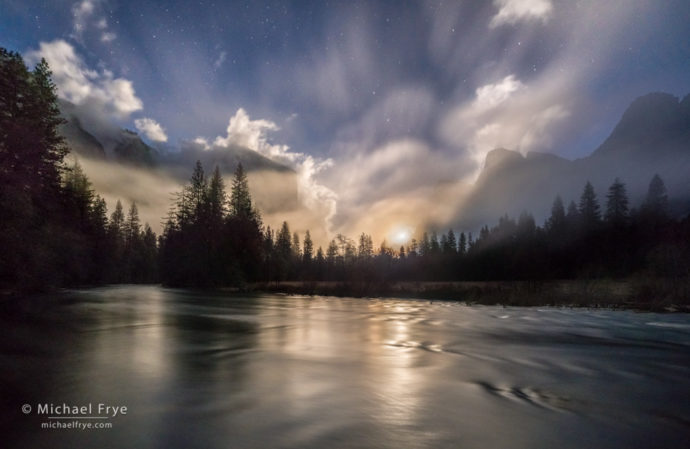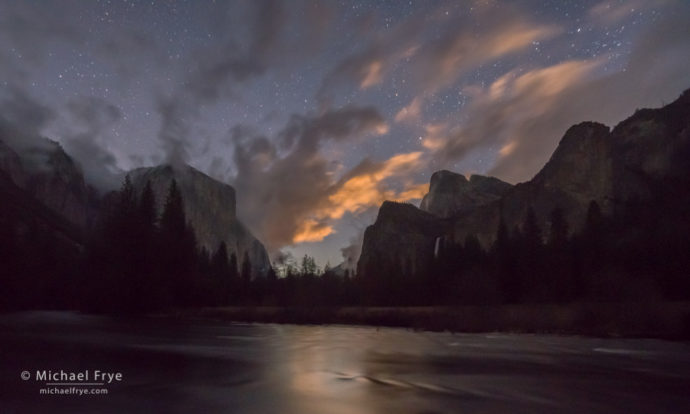As I described in my last post, I drove up to Yosemite Valley last Friday afternoon to see and photograph the high water. Then after sunset I hung around for awhile, waiting for the moon to rise.
The 86% moon was due to rise just after 8:00 p.m. When photographing a moonrise, moonset, sunrise, or sunset, one of the most important considerations is the exact angle or azimuth of the sun or moon. We all know that the sun rises in the east and sets in the west. Most people also know that in the summer, in the northern hemisphere, the sun rises and sets further north, and in the winter it rises and sets further south. The moon, of course, also rises in the east and sets in the west. But compared to the sun its path changes much more rapidly, varying as much in two weeks as the sun does in six months.
Consulting my PhotoPills app last Friday, I found that the moon would be rising to the east-northeast at an azimuth of 70 degrees – similar to the sunrise azimuth in spring. That’s not a great angle for the photogenic formations on the north side of the valley, like El Capitan, Three Brothers, and Yosemite Falls. It’s better for the cliffs on the south side of the valley, like Glacier Point and Cathedral Rocks, but to me those aren’t as interesting.
However, it occurred to me that the moon would be rising at almost the same angle as the sun back in May when I made this photo. Seeing the moon rise from Gates of the Valley (or Valley View) in that gap between El Capitan and Cathedral Rocks could be interesting, especially with some clouds or mist.
But after sunset on Friday there weren’t many clouds, and no mist. I thought about heading home, but decided to wait and see what might happen. I found some low clouds in the west end of the valley, and made a few photographs from Gates of the Valley by starlight. Then I drove back to the east end of the valley to see what was happening there, but there were few clouds, and no mist. I headed back to the Gates to await the moonrise.
After awhile I noticed the sky starting to lighten faintly in the east. Then suddenly the clouds lit up from the rising moon. Although I could see the light clearly, I couldn’t see the color until the images appeared on the back of my camera:
Around this time I noticed some mist forming near El Cap. The mist gradually lowered and got thicker. Then, through the mist, I saw a bright spot: the moon edging out from behind the valley walls. In no time the moonlight was streaming down the valley toward me, backlighting the clouds and mist, and creating beautiful silvery reflections in the river.
This was a gorgeous sight, but very difficult to photograph. The contrast was extreme, just as if I were looking into the sun, only it was darker, requiring longer exposures. I bracketed two sequences of five frames each, with each exposure two stops apart.
I figured that getting detail in the moon itself was hopeless, but I wanted to get detail in the mist next to the moon in order to avoid creating a large blob of blank, overexposed white in that area of the photo. The zebras in my Sony A7rII came in handy, allowing me to see what areas would be overexposed before making an exposure, and quickly find a starting point. The first exposure was 1.5 seconds at f/5.6, 400 ISO. Then for the second frame I increased the shutter speed to 6 seconds (two stops lighter). For the next exposure I didn’t want to lengthen the shutter speed again, as that would make the whole sequence too long (I was concerned about too much movement in the clouds, mist, and moon between frames), so instead I opened the aperture to f/4 (one stop), and increased the ISO to 800 (another stop, for a total of two). F/4 was the widest aperture on that lens, so for the fourth exposure I kept it at f/4 and increased the shutter speed to 10 seconds (one stop), and pushed the ISO to 1600 (another stop). For the final exposure of the sequence I increased the shutter speed one more stop to 20 seconds, and raised the ISO one stop to 3200.
With more time I probably could have figured out a more efficient way of doing this sequence, but there was no way to anticipate the exact brightness levels in advance, and little time to think about it once the moon appeared, so I just winged it and did the best I could. I repeated this sequence, and then the moon got too high, the mist started to dissipate, and the show was over. But it was spectacular while it lasted.
The final image at the top of this post was blended together from the first bracketed sequence. I actually ended up using only the last three frames of that sequence, as it turned out I didn’t need the first two exposures. Since the moon, clouds, mist, and water were all moving, I knew that HDR software would create too much ghosting, so instead I blended the three exposures by hand in Photoshop with layer masks. I used the last, lightest exposure for the water and dark trees. Most of the sky is from the second-lightest exposure, while I used the middle exposure just for the area around the moon. While blending this all together I realized that there was actually a corona around the moon (that ring of orange) – something that wasn’t visible in person.
It was a beautiful, special night. There was one other photographer there; I hope he got something good! After I left Gates of the Valley I headed up to Tunnel View, which was also pretty, though in a different way. I plan on posting one of the images from Tunnel View on Christmas Eve.
— Michael Frye
Related Posts: Misty Night; High Water in December; May Showers
Michael Frye is a professional photographer specializing in landscapes and nature. He is the author or principal photographer of The Photographer’s Guide to Yosemite, Yosemite Meditations, Yosemite Meditations for Women, Yosemite Meditations for Adventurers, and Digital Landscape Photography: In the Footsteps of Ansel Adams and the Great Masters. He has also written three eBooks: Light & Land: Landscapes in the Digital Darkroom, Exposure for Outdoor Photography, and Landscapes in Lightroom: The Essential Step-by-Step Guide. Michael has written numerous magazine articles on the art and technique of photography, and his images have been published in over thirty countries around the world. Michael has lived either in or near Yosemite National Park since 1983, currently residing just outside the park in Mariposa, California.











What lens did you use?
Sony 16-35mm f/4
What a wonderful commentary. Felt like I was there watching the moonrise with you. But I would have fumbled a lot more than you trying to get the right exposure(s)…
Thank you Wei – glad you liked the story.
A tour de force example of a seasoned pro knowing his camera and his technique stone-cold, not to mention beautiful artistry!
Thanks very much Gary!
Michael,
You are an artist that can take one venue and continually wring beautiful images out of Yosemite. I enjoy all your work.
Nicely done
Thank you Charles!